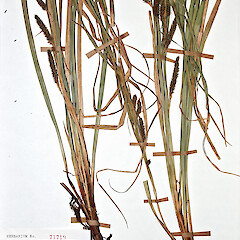Carex cockayneana
Common name
Cockayne’s sedge
Synonyms
Carex cinnamomea Cheeseman, C. forsteri var. cockayniana (Kük.) Kük.
Family
Cyperaceae
Flora category
Vascular – Native
Endemic taxon
Yes
Endemic genus
No
Endemic family
No
Structural class
Sedges
NVS code
The National Vegetation Survey (NVS) Databank is a physical archive and electronic databank containing records of over 94,000 vegetation survey plots - including data from over 19,000 permanent plots. NVS maintains a standard set of species code abbreviations that correspond to standard scientific plant names from the Ngä Tipu o Aotearoa - New Zealand Plants database.
CARCOC
Chromosome number
2n = c.60-66
Current conservation status
The conservation status of all known New Zealand vascular plant taxa at the rank of species and below were reassessed in 2017 using the New Zealand Threat Classification System (NZTCS) – more information about this can be found on the NZTCS website. This report includes a statistical summary and brief notes on changes since 2012 and replaces all previous NZTCS lists for vascular plants.
Please note, threat classifications are often suggested by authors when publications fall between NZTCS assessment periods – an interim threat classification status has not been assessed by the NZTCS panel.
- Conservation status of New Zealand indigenous vascular plants, 2017 . 2018. Peter J. de Lange, Jeremy R. Rolfe, John W. Barkla, Shannel P. Courtney, Paul D. Champion, Leon R. Perrie, Sarah M. Beadel, Kerry A. Ford, Ilse Breitwieser, Ines Schönberger, Rowan Hindmarsh-Walls, Peter B. Heenan and Kate Ladley. Department of Conservation. Source: NZTCS and licensed by DOC for reuse under the Creative Commons Attribution 4.0 International licence.
2017 | Not Threatened
Previous conservation statuses
2012 | Not Threatened
2009 | Not Threatened
2004 | Not Threatened
Distribution
Endemic. New Zealand: North Island (uncommon, near Wellington), South Island (scattered mainly in the west)
Habitat
Montane to subalpine. Usually along stream sides in montane forest or in subalpine scrub. Sometimes extending into tall tussock grassland where it grows around seepages, springs or tarns.
Detailed description
Culms 150–600 × 1–2 mm, smooth, trigonous, often drooping; basal sheaths dark red-brown. Leaves > culms, up to 800 × 3.0–6.5 mm. wide, double-folded, margins of upper half sharply scabrid. Inflorescence of 2–8 ± distant, red-brown or light brown spikes, the upper sessile, the lower drooping on filiform peduncles; terminal 1–(2) spikes entirely male or with few to numerous female flowers at the top, remaining spikes female with a few ± distant male flowers at the base, 10–70 × 5–10 mm. Glumes (excluding awn) ± = or slightly > utricles, ovate-lanceolate, acute and entire or slightly emarginate, membranous, light red-brown with a thickened green midrib produced to a slightly scabrid awn 1–2 mm long. Utricles 3–4 × c. 1 mm, unequally biconvex, fusiform, conspicuously costate when immature, turgid, smooth and slightly spreading when mature, yellowish brown, margins glabrous; beak narrow, 0.5–1.0 mm long, very shortly bifid, orifice slightly scabrid; stipe < 0.5 mm long. Stigmas 3. Nut 1.5–2.0 mm long, trigonous, obovoid-ellipsoid, dark brown.
Similar taxa
Somewhat similar to Carex spinirostris Colenso which is a more northerly species of offshore islands (especially around petrel burrows), coastal and lowland forest. Carex cockayneana differs from that species by the stouter, light red-brown or yellow-brown spikes. Carex cockayneana could be confused with C. forsteri Wahl. as both grow in similar habitats (though C. forsteri is more common at lower elevations) and both have greenish spikes. From C. forsteri, C. cockayneana differs by the utricles which are shorter, smooth (rather than nerved) and have a shorter beak and straight rather than oblique mouth.
Flowering
October–December
Fruiting
November–May
Life cycle
Nuts surrounded by inflated utricles are dispersed by granivory and wind (Thorsen et al., 2009).
Propagation technique
Easily grown from fresh seed and by the division of established plants. Best grown in a permanently damp situation in a shaded site but will tolerate full sun and dry conditions once established. An excellent plant for growing along shaded stream sides.
Etymology
carex: Latin name for a species of sedge, now applied to the whole group.
cockayneana: Named after Leonard Cockayne FRS (7 April 1855 - 8 July 1934) who is regarded as New Zealand’s greatest botanist and a founder of modern science in New Zealand
Where To Buy
Not commercially available.
Attribution
Fact Sheet prepared by P.J. de Lange (10 August 2006). Description adapted from Moore and Edgar (1970)
References and further reading
Moore LB, Edgar E. 1970. Flora of New Zealand, Volume II. Indigenous Tracheophyta: Monocotyledones except Gramineae. Government Printer, Wellington, NZ. 354 p.
Thorsen MJ, Dickinson KJM, Seddon PJ. 2009. Seed dispersal systems in the New Zealand flora. Perspectives in Plant Ecology, Evolution and Systematics 11: 285–309.
NZPCN Fact Sheet citation
Please cite as: de Lange, P.J. (Year at time of access): Carex cockayneana Fact Sheet (content continuously updated). New Zealand Plant Conservation Network. https://www.nzpcn.org.nz/flora/species/carex-cockayneana/ (Date website was queried)



